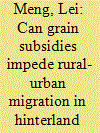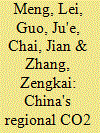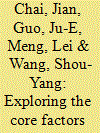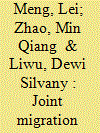|
|
|
Sort Order |
|
|
|
Items / Page
|
|
|
|
|
|
|
| Srl | Item |
| 1 |
ID:
128166


|
|
|
|
|
| Publication |
2012.
|
| Summary/Abstract |
In this paper I examine if China's grain subsidy program keeps farmers from engaging in migratory work using self-collected panel rural household survey data from Zhijiang, Hubei province. Making use of Zhijiang's unique geographical features, I construct a treatment and a control group and use a difference-in-differences methodology to identify the subsidy effect on migration. My results suggest that the grain subsidy policy does keep farmers at the rural origin.
|
|
|
|
|
|
|
|
|
|
|
|
|
|
|
|
| 2 |
ID:
111441


|
|
|
|
|
| Publication |
2012.
|
| Summary/Abstract |
Trades create a mechanism of embodied CO2 emissions transfer among regions, causing distortion on the total emissions. As the world's second largest economy, China has a large scale of trade, which results in the serious problem of embodied CO2 emissions transfer. This paper analyzes the characteristics of China's CO2 emissions embodied in international and interprovincial trade from the provincial perspective. The multi-regional Input-Output Model is used to clarify provincial CO2 emissions from geographical and sectoral dimensions, including 30 provinces and 28 sectors. Two calculating principles (production accounting principle and consumption accounting principle, Munksgaard and Pedersen, 2001) are applied. The results show that for international trade, the eastern area accounts for a large proportion in China's embodied CO2 emissions. The sectors as net exporters and importers of embodied CO2 emissions belong to labor-intensive and energy-intensive industries, respectively. For interprovincial trade, the net transfer of embodied CO2 emissions is from the eastern area to the central area, and energy-intensive industries are the main contributors. With the largest amount of direct CO2 emissions, the eastern area plays an important role in CO2 emissions reduction. The central and western areas need supportive policies to avoid the transfer of industries with high emissions.
|
|
|
|
|
|
|
|
|
|
|
|
|
|
|
|
| 3 |
ID:
109643


|
|
|
|
|
| Publication |
2011.
|
| Summary/Abstract |
This paper analyzes the characteristics of China's regional CO2 emissions and effects of economic growth and energy intensity using panel data from 1997 to 2009. The results show that there are remarkable regional disparities among eastern, central and western areas, regional elasticities of per capita GDP and energy intensity on CO2 emissions, which reflect the regional differences in economic development, economy structure and restraining function of energy intensity decrease on the emission. Energy intensity reducing is more effective to emission abatement for provinces with higher elasticity of energy intensity, but may not be significant for provinces with lower elasticity. The inverse distribution of energy production and consumption, regional unfairness caused by institutional factors like energy price and tax system result in inter-regional CO2 emission transfer embodied in the power transmission. The calculation indicates that the embodied emission transfer was gradually significant after 2003, from eastern area to the central and western areas, especially energy production provinces in central area, which leads to distortion on the emission and emission intensity. The regional emission reduction targets and supporting policies should be customized and consistent with the actual situations rather than setting the same target for all the provinces.
|
|
|
|
|
|
|
|
|
|
|
|
|
|
|
|
| 4 |
ID:
110741


|
|
|
|
|
| Publication |
2011.
|
| Summary/Abstract |
As the uncertainty of oil price increases, impacts of the influential factors on oil price vary over time. It is of great importance to explore the core factors and its time-varying influence on oil price. In view of this, based on the PATH-ANALYSIS model, this paper obtains the core factors, builds an oil price system VAR model, which uses demand, supply, price, and inventory as endogenous variables, and China's net imports as well as dollar index as exogenous variables. Then we set up a BVAR-TVP (Time varying parameter) model to analyze dynamic impacts of core factors on oil price. The results show that: (1) oil prices became more sensitive to oil supply changes, and the influence delays became shorter; (2) the impact of oil inventories on oil prices with a time lag of two quarters but has a downward trend; (3) the impact of oil consumption on oil prices with a time lag of two quarters, and this effect is increasingly greater; (4) the US dollar index is always the important factor of oil price and its control power increases gradually, and the financial crisis (occurred in 2008) further strengthens the influence of US dollar.
|
|
|
|
|
|
|
|
|
|
|
|
|
|
|
|
| 5 |
ID:
147439


|
|
|
|
|
| Summary/Abstract |
In this paper we investigate whether it is empirically important to take into account the joint migration behavior of couples when examining married individuals' migration decisions in rural China. According to the National Bureau of Statistics of China (2011), more than half of rural migrant workers are married. Married couples' migration decisions are not purely individual responses to different social and economic opportunities, but jointly determined within a family unit. The current approaches that examine Chinese migration issues do not explicitly take into account the fundamental differences between personal and family decisions. We extend the current approaches to explicitly model joint migration decisions of married couples. Using the 2009 China data from the Rural–Urban Migration in China and Indonesia (RUMiCI) project, we examine the important determinants of couples' temporary migration decisions, such as the numbers of pre-school and school-age children. Our simulation and estimation results show that when analyzing married persons' migration choices, it is more desirable to use a multiple-choice model than a binary-choice model because 1) it more effectively deals with nonlinearities created by joint decision-making; and 2) it offers the possibility to study compositional change of joint migration outcomes.
|
|
|
|
|
|
|
|
|
|
|
|
|
|
|
|
| 6 |
ID:
161883


|
|
|
|
|
| Summary/Abstract |
We use a unique, self-collected dataset to study the trade-offs between rural land holding and urban hukou facing Chinese rural households. Exploring the criteria used in the initial land allocation in the early 1980s, we argue that our finding of a negative relationship between land holding and permanent migration in terms of hukou change has a causal interpretation. We also contribute to the literature by empirically examining the impact of land holding on temporary and permanent migration decisions simultaneously. We find that land holding reduces the likelihood of permanent migration but has a smaller effect on temporary migration decisions. Using a hypothetical survey question, we find that providing full access to urban social benefits to even “landless” households would result in only a moderate increase in the number of rural individuals intending to settle permanently in urban areas. Our results suggest that reforms of rural land rights and urban social benefits alone may not be sufficient to attract a large proportion of rural individuals to permanently settle in urban areas.
|
|
|
|
|
|
|
|
|
|
|
|
|
|
|
|
|
|
|
|
|